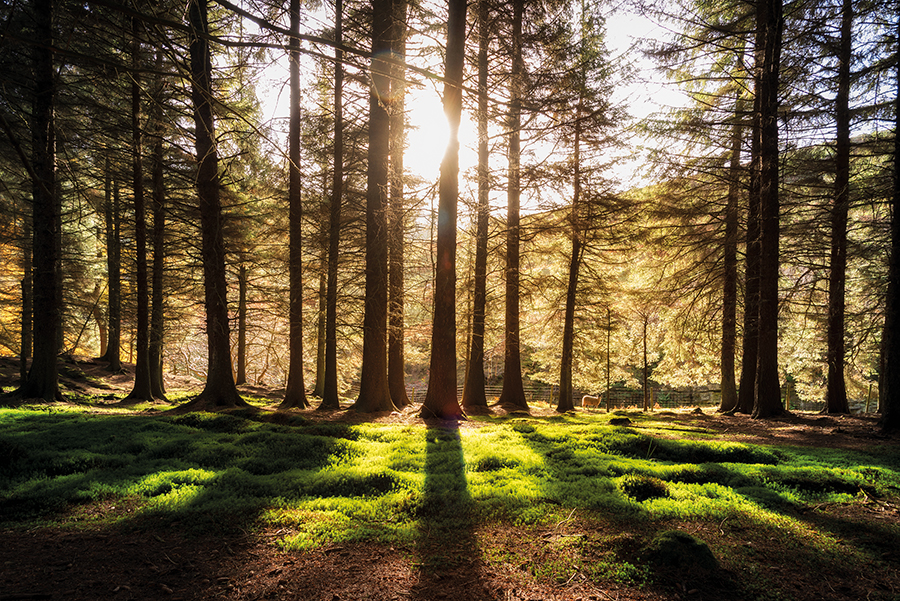Key woodland management tasks this autumn
10th September 2024
Autumn is an ideal time to ensure your woodland is in the best health for the colder winter months.

With a number of grants and incentives available for woodland creation, more farmers are utilising poorer quality land for tree planting – and with autumn being a key time in the woodland calendar, we take a look at some of the important tasks to get done this season.
The Forestry Commission provides the following advice…
Check your tree guards
With scrub and weed growth dying down in autumn, now is a good time to remove or replace tree guards that are no longer needed. However, you should consider using weed control around young trees if they are becoming overtopped, and cut bracken before it folds over onto the trees. Even in a mild winter, competing vegetation can continue to grow, so trees could become swamped by spring, even if you can still see them now.
Whilst tree guards offer important protection for young trees, they can also become a hiding spot for weeds and small mammals. Young trees are very vulnerable to competition for moisture – if needed you can gently lift the guard to expose the tree base and access the weeds’ roots, and while you’re there check for vole damage to the bark.
Plastic guards removed from trees are subject to waste legislation and regulation so must be recycled appropriately, or it may be possible to reuse them if they are not damaged or degraded.
Put up protective fencing
If it’s not already in place, fencing should be put up to keep livestock and deer away from trees – the drop in temperature during autumn and likelihood of rain leads to softer ground. If using machinery to build protective fencing, avoid soil compaction around tree roots.
Sap sinks in the trees during late autumn, so pruning, thinning or tree maintenance should be done before this occurs – especially for broadleaves to prevent the trees bleeding sap and becoming distressed. Now is also a good time to carry out any necessary felling as birds will have fledged the nest and dormice are not yet hibernating. If you’re carrying out hardwood felling, you will also be ready for the annual winter hardwood auctions.
Check if you need a felling licence before carrying out work through the Forestry Commission’s guide here.
Check tree health
Tree health is always a top priority and it’s easy to spot which ones are struggling when the trees are in full leaf – dying or diseased trees are obvious from their thin or absent crowns. But once autumn gets in full swing and the leaves are off, signs of disease can be harder to detect – so where this is the case watch out for: lesions and weeping on the bark, trees holding onto their dead leaves and dying twiggy branches in the crown.
If trees are showing signs of diseases including Chalara ash dieback, acute oak decline, sweet chestnut blight, or Phytophthora ramorum, they should be reported via the Tree Alert portal. Once a tree has died it should be left in situ if it’s safe to do so, unless you are instructed by the Forestry Commission to fell it. Deadwood, especially standing deadwood, is a rare but vital aspect of a healthy woodland – and benefits organisms like fungi and bacteria, as well as beetles, bees and bats.
Biosecurity measures can help protect trees from pests and disease – if possible ask visitors to clean their shoes and vehicles before entering, and once they leave the woodland. This stops fungal diseases being spread through leaf litter.
Choosing new trees
Autumn is a good time to choose and order new trees if you’re planning to expand your woodland or replant any felled areas. To help avoid pests and disease, use biosecure trees from nurseries with Plant Healthy certification or similar.
The Woodland Trust recommends buying trees that have never been overseas, as one of the simplest and most effective ways of protecting trees from new pests and disease.
When new species are imported from overseas, native trees have no natural defences against them, and predators that keep these species in check in their natural range may not be present. The trust, whose trees are certified UK sourced and grown, also warns against trees that have only been sourced (not grown) in the UK, and trees that are grown in the UK but not sourced here – as both still come with risks.
Once you’ve taken delivery of the new trees, handle them carefully, store them in a well-ventilated area and be aware that bare root trees have a short shelf life of around two weeks, while cell grown trees offer more flexibility with a longer shelf life.
Trees planted before the end of the year will have a chance to grow new roots sooner and will be able to survive any potential spring droughts – though they can be planted any time before very early spring.
Read more farm business news
